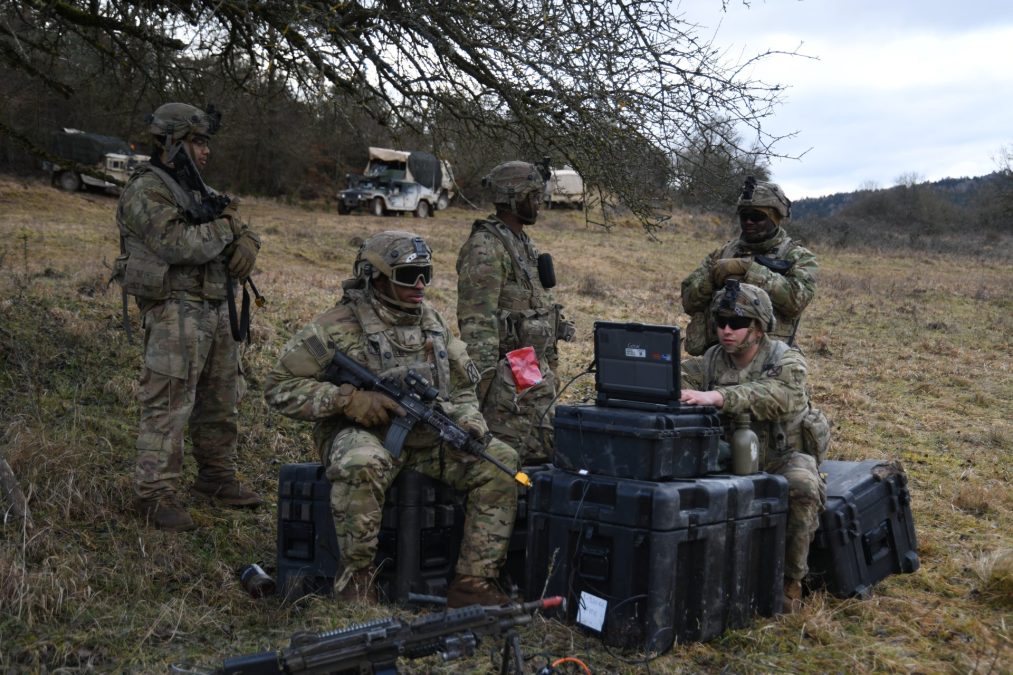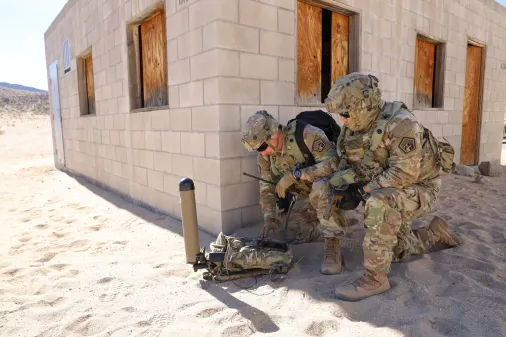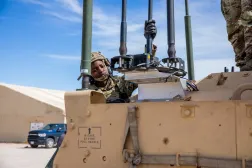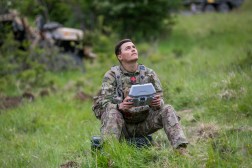Updated network gear allows US soldiers to be more dispersed with lower digital footprints

This is part two of a three-part series examining the conclusion of the Army’s transforming-in-contact 1.0 initiative and looking forward to the next iteration. Part one can be found here.
Modernized network capabilities tested during a recent exercise in Europe allowed U.S. military forces to operate more dispersed with lower electronic footprints — making them hard for the enemy to discover.
That unit, 3rd Brigade, 10th Mountain Division, was the last of three experimental brigades testing the first iteration of a concept dubbed transforming-in-contact, a top priority for the Army that aims to change the way the service buys, trains and employs equipment.
The concept aims to use deployments and troop rotations to test new equipment — mainly commercial off-the-shelf gear — that could allow units to be more responsive on a dynamic battlefield. It’s focused initially on unmanned aerial systems, counter-UAS and electronic warfare.
The brigade was fielded some newer networking equipment for communication and command and control. While not the full kit that other units across the Army have received, the Command and Control Fix architecture, as it’s known, proved dividends. It’s focused on bolstering soldiers’ so-called “fight tonight” ability with existing technology until a permanent solution is developed.
“We had a really hard time figuring out the networking capability,” Maj. Mark Matthey, executive officer of 1st Battalion, 4th Infantry Regiment, the opposing force at the Joint Multinational Readiness Center in Hohenfels, Germany, which goes against all the rotating brigades, said in an interview.
“What we struggled to do on this one was we weren’t picking up much of their signals,” he added. “What we were able to do is we were able to fly our own [intelligence, surveillance and reconnaissance platforms] against them and see that they were dispersed.”
In some regards, 3rd Brigade, 10th Mountain had the advantage of taking lessons from the first two units that already conducted their transforming-in-contact rotations and applying those to their operations.
“The things in particular that we took from 2nd Brigade, 101st and 2nd Brigade, 25th really revolved around how they were employing some of these new capabilities on what we’re preparing for in the modern battlefield,” Col. Joshua Glonek, commander of 3rd Brigade, 10th Mountain, said in an interview. “In talking about use cases and what worked well, what didn’t work well … we fielded the new C2 Fix communications architecture, talking about how to employ the communications network to the greatest extent: where to place your, what are called variable height antennas — basically drone retrains — other drones, how to communicate over the Starshield for transport, how to use new applications, new software that allows for, you know, communications to happen over chat, essentially, rather than just doing voice communications for everything. Those were a lot of the things that we took from their rotations and applied to our own and tried to move to the next level of employment in a lot of different ways.”
3rd Brigade, however, received some different capabilities from those units and employed some of them a bit differently due to the terrain and opposing force it was facing — a key tenet of the transforming-in-contact concept to test what works and what doesn’t for all types of units around the globe.
The technology allowed soldiers to disperse effectively across the battlespace, which not only made them hard to find physically, but it significantly reduced their electromagnetic signatures.
Russia has demonstrated to great effect — both in its current war with Ukraine and its 2014 inclusion there as well — that it can detect units’ locations based solely on their electromagnetic emissions and fire upon them.
“Keeping a low electromagnetic signature was incredibly important. We learned how the other brigades had disaggregated their command posts, displaced their antennas away from their command posts, broken them up into smaller pieces and spread them out around the battlefield. We replicated that same type of CP setup in order to do that and to stay hidden from the adversary,” Glonek said.
Matthey explained that his forces had a difficult time locating the unit within the spectrum, in large part due to the variety of communications paths and capabilities 3rd Brigade was using, not just relying on the very well know signature of FM radios.
Commercial satellite constellations such as Starlink and Starshield proved effective as well as using commercial encrypted applications such as Wickr to pass data, enabled by the internet provide by those constellations.
“It provides a lower signature because the enemy is usually out there detecting for radio signals, but information that’s being transported up to satellites and back down, you’re a little less vulnerable,” Glonek said of Wickr.
Command post dispersion
Glonek noted that he was able to split his brigade command post into three different nodes: a main command post, a tactical command post, and a support command post that housed a lot of administrative and logistical functions further from the front lines for more protection.
Starlink and Starshield allowed them to be more mobile and access communications much faster. The tactical command post used the Next Generation Tactical Vehicle, a prototype that is a souped-up Chevy Silverado. The truck has a diesel engine powered with batteries that drive the vehicle, meaning it is silent when in motion.
Those batteries provide a significant amount of onboard power where radios and Starshield can be plugged into. And since this is a highly mobile truck, it can hide in the woods, be functional for 15 minutes with all the communications gear and then move.
Officials have learned that on the modern battlefield, units must rapidly move or risk being discovered, either by their electronic signatures or from the myriad drones flooding the environment and providing unrelenting surveillance. This means they need communications capabilities that can enable quick set up or even on the move, a departure from the past where these capabilities, in some cases, took over an hour to establish comms.
However, although 3rd Brigade was successful at overall dispersion and creating dilemmas for the opposing force, the unit still struggled at lower echelons.
“In talking to a couple of their units in the [after action reviews], I let them know like, ‘Hey, dispersion was great at your level, at the battalion commanders level, it was great. It was terrible at the company and platoon level,’” Matthey said. “That’s our assessment of it was like we just didn’t see the platoon level using it, and we saw the company levels trying, and then the battalion and brigade obviously doing a pretty good job of it.”
Those smaller units were not far enough apart when the opposing force was conducting reconnaissance, meaning they were able to locate all of its subordinate units because they were too close together.
Matthey chalked this up to old habits dying hard.
“I think it was just not normal for them,” he said. “It comes back to, at the end of the day, the skill level and the proficiency of using the new equipment is the most important thing.”
Overall, officials lauded the level of flexibility the new communications gear provided. As the Army has been on a multiyear journey to modernize its network, a key tenet program officials have expressed is the ability for units and commanders to tailor the equipment to their specific needs. This ultimately means each unit in the Army will look slightly different and the technology is enabling that level of customization.
“One of the strengths [is] that more modular nature allows the brigade commander and his signal corps component to structure the network and their mission command system in a way that meets their mission and how they want to operate,” Col. Matt Davis, cyber and electromagnetic chief and transformation chief for V Corps, said in an interview. “Having that kind of flexibility … when we started that’s, I think, pretty new for us as an Army, having the ability to adapt your mission command system on the go to the needs of the mission. That’s a flexibility that hasn’t existed before.”
Electronic decoys
The Army — along with the rest of the military — got away from advanced electronic warfare techniques after the end of the Cold War, and now the service is having to reinvest in capabilities and tactics.
The Army in 2023 awarded the first program-of-record jammer in decades — a portable backpack capability that conducts sensing with limited jamming. The service is still is evaluating an approach for more powerful platform-based jamming following the decision to move away from one of its programs last year.
As officials noted, they need to exercise how to sense the environment for signals and understand how to conduct those maneuvers in order to be effective at jamming.
3rd Brigade, 10th Mountain didn’t test any electronic jamming capabilities. Instead it sought to improve how it senses the environment. It did, however, test electromagnetic decoys against the opposing force, a key capability for deceiving enemies on the modern battlefield.
While 2nd Brigade, 101st tested decoys to great effect — deploying the devices that displayed signatures of entire units to entice the enemy to waste artillery firing upon them —3rd Brigade, 10th Mountain knew that technique wouldn’t work against its opposing force.
The opposing force in Germany would always confirm electromagnetic detection with visual confirmation. That meant that in contrast to the setup for the 101st, where the enemy would simply detect the signal and fire upon it, if a signal of interested was discovered 1st Battalion, 4th Infantry Regiment would have to send a scout or a drone to validate that there were physical assets there.
Understanding that, 3rd Brigade paired inflatable M777 howitzers with its decoys, providing the physical evidence needed to deceive the enemy.
“We put those howitzers out with the electromagnetic decoy as part of a deception effort and we placed these at night near our normal artillery positions. And by the next morning the enemy had detected the signature of that deception kit that did confirm its presence through scouts and actually got eyes on and believed that they were viewing real artillery cannons,” Glonek said. “Then they shot a fire mission at it, which is exactly what we wanted them to do… [and] allowed us to immediately counter-fire and then destroy their real artillery. That was something that we put a lot of thought into to see if we could make that work. Within the first day we put it out, within six hours that happened and we were able to destroy their artillery with it.”
Part three of this series will examine what is to come with transforming-in-contact 2.0.






